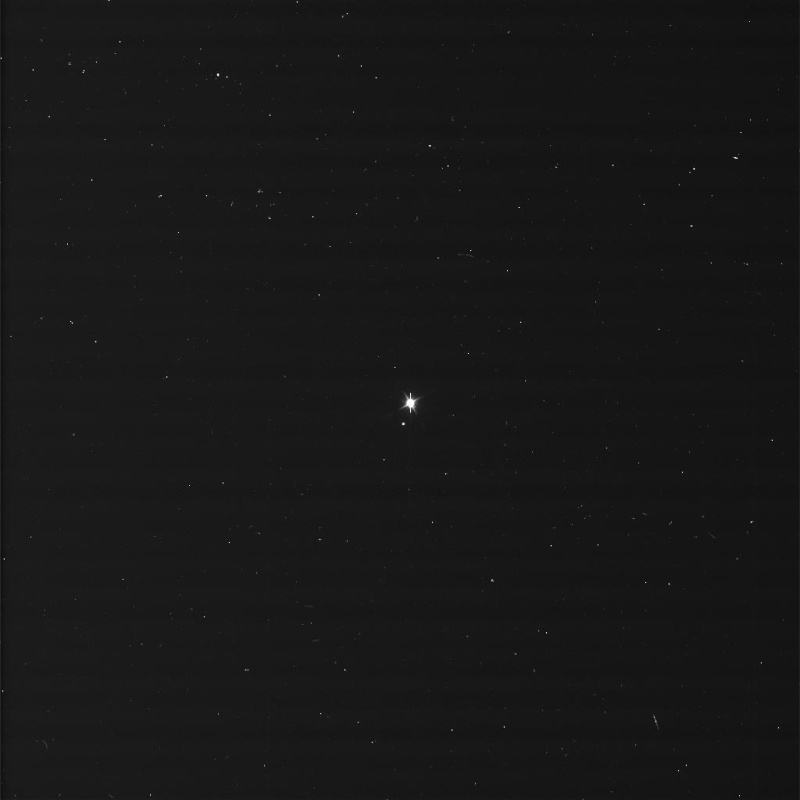Don't miss this one!
New surveys conducted by NASA's Swift provide the most detailed overviews ever captured in ultraviolet light of the Large and Small Magellanic Clouds, the two closest major galaxies to our own. Swift team member Stefan Immler, who proposed the imaging project, narrates this quick tour.
NASA's Swift Produces Best Ultraviolet Maps of the Nearest Galaxies
WASHINGTON -- Astronomers at NASA and Pennsylvania State University have used NASA's Swift satellite to create the most detailed ultraviolet light surveys ever of the Large and Small Magellanic Clouds, the two closest major galaxies.
"We took thousands of images and assembled them into seamless portraits of the main body of each galaxy, resulting in the highest-resolution surveys of the Magellanic Clouds at ultraviolet wavelengths," said Stefan Immler, who proposed the program and led NASA's contribution from the agency's Goddard Space Flight Center in Greenbelt, Md.
Immler presented a 160-megapixel mosaic image of the Large Magellanic Cloud (LMC) and a 57-megapixel mosaic image of the Small Magellanic Cloud (SMC) at the 222nd American Astronomical Society meeting in Indianapolis on Monday.
The new images reveal about 1 million ultraviolet sources in the LMC and about 250,000 in the SMC. The images include light ranging from 1,600 to 3,300 angstroms, which is a range of UV wavelengths largely blocked by Earth's atmosphere.
"Prior to these images, there were relatively few UV observations of these galaxies, and none at high resolution across such wide areas, so this project fills in a major missing piece of the scientific puzzle," said Michael Siegel, lead scientist for Swift's Ultraviolet/Optical Telescope (UVOT) at the Swift Mission Operations Center at the university in State College, Pa.
The LMC and SMC lie about 163,000 light-years and 200,000 light-years away, respectively, and orbit each other as well as our own Milky Way galaxy. The LMC is about one-tenth the size of the Milky Way and contains only 1 percent of the Milky Way's mass. The SMC is half the size of the LMC and contains about two-thirds of its mass.
Despite their modest sizes, the galaxies loom large in the sky because they are so close to us. Both extend far beyond the UVOT's field of view, which meant thousands of images were needed in order to cover both galaxies in three ultraviolet colors centered at wavelengths of 1,928 angstroms, 2,246 angstroms, and 2,600 angstroms.
Viewing in the ultraviolet allows astronomers to suppress the light of normal stars like the sun, which are not very bright at such higher energies, and provides a clearer picture of the hottest stars and star-formation regions. No telescope other than UVOT can produce such high-resolution wide-field multicolor surveys in the ultraviolet. Swift's wide-field imaging capabilities provide a powerful complement to the deeper, but much narrower-field imaging power of NASA's Hubble Space Telescope.
To produce the 160-megapixel LMC mosaic, Swift's UVOT acquired 2,200 snapshots for a cumulative exposure of 5.4 days. The 57-megapixel SMC image comprises 656 individual images with a total exposure of 1.8 days.
Both images have an angular resolution of 2.5 arcseconds, which is a measure of their sharpness. Sources separated by this angle, which is equivalent to the size of a dime seen from 1 mile away, are visible as distinct objects.
"With these mosaics, we can study how stars are born and evolve across each galaxy in a single view, something that's very difficult to accomplish for our own galaxy because of our location inside it," Immler said.
The Large and Small Magellanic Clouds are readily visible from the Southern Hemisphere as faint, glowing patches in the night sky. The galaxies are named after Ferdinand Magellan, the Portuguese explorer who in 1519 led an expedition to sail around the world. He and his crew were among the first Europeans to sight the objects.
Pennsylvania State University manages the Swift Mission Operations Center, which controls Swift's science and flight operations. Goddard manages Swift, which was launched in November 2004. The satellite is operated in collaboration with Penn State, the Los Alamos National Laboratory in New Mexico and Orbital Sciences Corp. in Dulles, Va. International collaborators are in the United Kingdom and Italy, and the mission includes contributions from Germany and Japan.
For images related to this release, please visit:
http://go.nasa.gov/16wz7da
For more information about Swift, visit:
http://www.nasa.gov/swift
New surveys conducted by NASA's Swift provide the most detailed overviews ever captured in ultraviolet light of the Large and Small Magellanic Clouds, the two closest major galaxies to our own. Swift team member Stefan Immler, who proposed the imaging project, narrates this quick tour.
NASA's Swift Produces Best Ultraviolet Maps of the Nearest Galaxies
WASHINGTON -- Astronomers at NASA and Pennsylvania State University have used NASA's Swift satellite to create the most detailed ultraviolet light surveys ever of the Large and Small Magellanic Clouds, the two closest major galaxies.
"We took thousands of images and assembled them into seamless portraits of the main body of each galaxy, resulting in the highest-resolution surveys of the Magellanic Clouds at ultraviolet wavelengths," said Stefan Immler, who proposed the program and led NASA's contribution from the agency's Goddard Space Flight Center in Greenbelt, Md.
Immler presented a 160-megapixel mosaic image of the Large Magellanic Cloud (LMC) and a 57-megapixel mosaic image of the Small Magellanic Cloud (SMC) at the 222nd American Astronomical Society meeting in Indianapolis on Monday.
The new images reveal about 1 million ultraviolet sources in the LMC and about 250,000 in the SMC. The images include light ranging from 1,600 to 3,300 angstroms, which is a range of UV wavelengths largely blocked by Earth's atmosphere.
"Prior to these images, there were relatively few UV observations of these galaxies, and none at high resolution across such wide areas, so this project fills in a major missing piece of the scientific puzzle," said Michael Siegel, lead scientist for Swift's Ultraviolet/Optical Telescope (UVOT) at the Swift Mission Operations Center at the university in State College, Pa.
The LMC and SMC lie about 163,000 light-years and 200,000 light-years away, respectively, and orbit each other as well as our own Milky Way galaxy. The LMC is about one-tenth the size of the Milky Way and contains only 1 percent of the Milky Way's mass. The SMC is half the size of the LMC and contains about two-thirds of its mass.
Despite their modest sizes, the galaxies loom large in the sky because they are so close to us. Both extend far beyond the UVOT's field of view, which meant thousands of images were needed in order to cover both galaxies in three ultraviolet colors centered at wavelengths of 1,928 angstroms, 2,246 angstroms, and 2,600 angstroms.
Viewing in the ultraviolet allows astronomers to suppress the light of normal stars like the sun, which are not very bright at such higher energies, and provides a clearer picture of the hottest stars and star-formation regions. No telescope other than UVOT can produce such high-resolution wide-field multicolor surveys in the ultraviolet. Swift's wide-field imaging capabilities provide a powerful complement to the deeper, but much narrower-field imaging power of NASA's Hubble Space Telescope.
To produce the 160-megapixel LMC mosaic, Swift's UVOT acquired 2,200 snapshots for a cumulative exposure of 5.4 days. The 57-megapixel SMC image comprises 656 individual images with a total exposure of 1.8 days.
Both images have an angular resolution of 2.5 arcseconds, which is a measure of their sharpness. Sources separated by this angle, which is equivalent to the size of a dime seen from 1 mile away, are visible as distinct objects.
"With these mosaics, we can study how stars are born and evolve across each galaxy in a single view, something that's very difficult to accomplish for our own galaxy because of our location inside it," Immler said.
The Large and Small Magellanic Clouds are readily visible from the Southern Hemisphere as faint, glowing patches in the night sky. The galaxies are named after Ferdinand Magellan, the Portuguese explorer who in 1519 led an expedition to sail around the world. He and his crew were among the first Europeans to sight the objects.
Pennsylvania State University manages the Swift Mission Operations Center, which controls Swift's science and flight operations. Goddard manages Swift, which was launched in November 2004. The satellite is operated in collaboration with Penn State, the Los Alamos National Laboratory in New Mexico and Orbital Sciences Corp. in Dulles, Va. International collaborators are in the United Kingdom and Italy, and the mission includes contributions from Germany and Japan.
For images related to this release, please visit:
http://go.nasa.gov/16wz7da
For more information about Swift, visit:
http://www.nasa.gov/swift
Last edited by Tom on Wed Jun 05, 2013 8:42 am; edited 2 times in total

 Home
Home



 " />
" /> " />
" /> " />
" />












